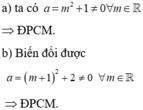Bài 2: Chứng minh các PT sau là PT bậc nhất một ẩn
a) ( m2 + m + 1 ) x - 3 = 0
b) ( m2 + 2m + 3 ) x - m + 1 = )
Hãy nhập câu hỏi của bạn vào đây, nếu là tài khoản VIP, bạn sẽ được ưu tiên trả lời.

a: \(m^2+m+1=m^2+2\cdot m\cdot\dfrac{1}{2}+\dfrac{1}{4}+\dfrac{3}{4}=\left(m+\dfrac{1}{2}\right)^2+\dfrac{3}{4}>0\)
Do đó: Phương trình \(\left(m^2+m+1\right)x-3=0\) luôn là pt bậc nhất 1 ẩn
b: \(m^2+2m+3=\left(m+1\right)^2+2>0\)
Do đó: Phương trình \(\left(m^2+2m+3\right)x-m+1=0\) luôn là pt bậc nhất 1 ẩn
a, Ta có : \(m^2+m+1=m^2+m+\dfrac{1}{4}+\dfrac{3}{4}=\left(m+\dfrac{1}{2}\right)^2+\dfrac{3}{4}>0\)
Vậy ta có đpcm
b, Ta có : \(m^2+2m+3=m^2+2m+1+2=\left(m+1\right)^2+2>0\)
Vậy ta có đpcm

a: Để đây là phương trình bậc nhất một ẩn thì (m-2)(m+2)<>0
hay \(m\notin\left\{2;-2\right\}\)
b: Để đây là phương trình bậc nhất một ẩn thì \(m^2-3< >0\)
hay \(m\notin\left\{\sqrt{3};-\sqrt{3}\right\}\)

a. m2 ≥ 0 ∀ m
=> m2 +1> 0 ∀ m
b. m2 +2m +3 = m2 + 2m +1 +2 = (m + 1)2 + 2 > 0 ∀ m
c. m2 ≥ 0 ∀ m
=> m2 +2> 0 ∀ m
d. m2 - 2m +2 = m2 -2m + 1 +1 = (m - 1)2 + 1 > 0 ∀ m
a) Để phương trình \(\left(m^2+1\right)x-3=0\) là phương trình bậc nhất một ẩn thì \(m^2+1\ne0\)
\(\Leftrightarrow m^2\ne-1\)
mà \(m^2\ge0\forall m\)
nên \(m^2\ne-1\forall m\)
\(\Leftrightarrow m^2+1\ne0\forall m\)
Vậy: Phương trình \(\left(m^2+1\right)x-3=0\) là phương trình bậc nhất một ẩn với mọi giá trị của tham số m
b) Để phương trình \(\left(m^2+2m+3\right)x+m-1=0\) là phương trình bậc nhất một ẩn thì \(m^2+2m+3\ne0\)
\(\Leftrightarrow\left(m+1\right)^2+2\ne0\)
mà \(\left(m+1\right)^2+2\ge2>0\forall m\)
nên \(\left(m+1\right)^2+2\ne0\forall m\)
hay \(m^2+2m+3\ne0\forall m\)
Vậy: Phương trình \(\left(m^2+2m+3\right)x+m-1=0\) luôn là phương trình bậc nhất một ẩn với mọi tham số m
c) Để phương trình \(\left(m^2+2\right)x-4=0\) là phương trình bậc nhất một ẩn thì \(m^2+2\ne0\)
\(\Leftrightarrow m^2\ne-2\)
mà \(m^2\ge0\forall m\)
nên \(m^2\ne-2\forall m\)
\(\Leftrightarrow m^2+2\ne0\forall m\)
Vậy: Phương trình \(\left(m^2+2\right)x+4=0\) là phương trình bậc nhất một ẩn với mọi giá trị của tham số m
d) Để phương trình \(\left(m^2-2m+2\right)x+m=0\) là phương trình bậc nhất một ẩn thì \(m^2-2m+2\ne0\)
\(\Leftrightarrow\left(m-1\right)^2+1\ne0\)
mà \(\left(m-1\right)^2+1\ge1>0\forall m\)
nên \(\left(m-1\right)^2+1\ne0\forall m\)
hay \(m^2-2m+2\ne0\forall m\)
Vậy: Phương trình \(\left(m^2-2m+2\right)x+m=0\) luôn là phương trình bậc nhất một ẩn với mọi tham số m

a: khi m=1 thì pt sẽ là:
x^2+3x+1=0
=>\(x=\dfrac{-3\pm\sqrt{5}}{2}\)
b: Δ=(2m+1)^2-4m^2
=4m+1
Để phương trình có nghiệm kép thì 4m+1=0
=>m=-1/4
Khi m=-1/4 thì pt sẽ là:
x^2+x*(-1/4*2+1)+(-1/4)^2=0
=>x^2+1/2x+1/16=0
=>(x+1/4)^2=0
=>x+1/4=0
=>x=-1/4

Bài 1:
a, Thay m=-1 vào (1) ta có:
\(x^2-2\left(-1+1\right)x+\left(-1\right)^2+7=0\\
\Leftrightarrow x^2+1+7=0\\
\Leftrightarrow x^2+8=0\left(vô.lí\right)\)
Thay m=3 vào (1) ta có:
\(x^2-2\left(3+1\right)x+3^2+7=0\\ \Leftrightarrow x^2-2.4x+9+7=0\\ \Leftrightarrow x^2-8x+16=0\\ \Leftrightarrow\left(x-4\right)^2=0\\ \Leftrightarrow x-4=0\\ \Leftrightarrow x=4\)
b, Thay x=4 vào (1) ta có:
\(4^2-2\left(m+1\right).4+m^2+7=0\\ \Leftrightarrow16-8\left(m+1\right)+m^2+7=0\\ \Leftrightarrow m^2+23-8m-8=0\\ \Leftrightarrow m^2-8m+15=0\\ \Leftrightarrow\left(m^2-3m\right)-\left(5m-15\right)=0\\ \Leftrightarrow m\left(m-3\right)-5\left(m-3\right)=0\\ \Leftrightarrow\left(m-3\right)\left(m-5\right)=0\\ \Leftrightarrow\left[{}\begin{matrix}m=3\\m=5\end{matrix}\right.\)
c, \(\Delta'=\left[-\left(m+1\right)\right]^2-\left(m^2+7\right)=m^2+2m+1-m^2-7=2m-6\)
Để pt có 2 nghiệm thì \(\Delta'\ge0\Leftrightarrow2m-6\ge0\Leftrightarrow m\ge3\)
Theo Vi-ét:\(\left\{{}\begin{matrix}x_1+x_2=2m+2\\x_1x_2=m^2+7\end{matrix}\right.\)
\(x_1^2+x_2^2=0\\ \Leftrightarrow\left(x_1+x_2\right)^2-2x_1x_2=0\\ \Leftrightarrow\left(2m+2\right)^2-2\left(m^2+7\right)=0\\ \Leftrightarrow4m^2+8m+4-2m^2-14=0\\ \Leftrightarrow2m^2+8m-10=0\\ \Leftrightarrow\left[{}\begin{matrix}m=1\left(ktm\right)\\m=-5\left(ktm\right)\end{matrix}\right.\)
\(x_1-x_2=0\\ \Leftrightarrow\left(x_1-x_2\right)^2=0\\ \Leftrightarrow\left(x_1+x_2\right)^2-4x_1x_2=0\\ \Leftrightarrow\left(2m+2\right)^2-4\left(m^2+7\right)=0\\ \Leftrightarrow4m^2+8m+4-4m^2-28=0\\ \Leftrightarrow8m=28=0\\ \Leftrightarrow m=\dfrac{7}{2}\left(tm\right)\)
Bài 2:
a,Thay m=-2 vào (1) ta có:
\(x^2-2x-\left(-2\right)^2-4=0\\ \Leftrightarrow x^2-2x-4-4=0\\ \Leftrightarrow x^2-2x-8=0\\ \Leftrightarrow\left[{}\begin{matrix}x=4\\x=-2\end{matrix}\right.\)
b, \(\Delta'=\left(-m\right)^2-\left(-m^2-4\right)\ge0=m^2+m^2+4=2m^2+4>0\)
Suy ra pt luôn có 2 nghiệm phân biệt
Theo Vi-ét:\(\left\{{}\begin{matrix}x_1+x_2=2\\x_1x_2=-m^2-4\end{matrix}\right.\)
\(x_1^2+x_2^2=20\\ \Leftrightarrow\left(x_1+x_2\right)^2-2x_1x_2=20\\ \Leftrightarrow2^2-2\left(-m^2-4\right)=20\\ \Leftrightarrow4+2m^2+8-20=0\\ \Leftrightarrow2m^2-8=0\\ \Leftrightarrow m=\pm2\)
\(x_1^3+x_2^3=56\\ \Leftrightarrow\left(x_1+x_2\right)^3-3x_1x_2\left(x_1+x_2\right)=56\\ \Leftrightarrow2^3-3\left(-m^2-4\right).2=56\\ \Leftrightarrow8-6\left(-m^2-4\right)-56\\ =0\\ \Leftrightarrow8+6m^2+24-56=0\\ \Leftrightarrow6m^2-24=0\\ \Leftrightarrow m=\pm2\)
\(x_1-x_2=10\\ \Leftrightarrow\left(x_1-x_2\right)^2=100\\ \Leftrightarrow\left(x_1+x_2\right)^2-4x_1x_2-100=0\\ \Leftrightarrow2^2-4\left(-m^2-4\right)-100=0\\ \Leftrightarrow4+4m^2+16-100=0\\ \Leftrightarrow4m^2-80=0\\ \Leftrightarrow m=\pm2\sqrt{5}\)


Bài 2:
\(a,m^2+m+1=\left(m+\frac{1}{2}\right)^2+\frac{3}{4}\ge\frac{3}{4}>0\)
=> PT \(\left(m^2+m+1\right)x-3=0\) là pt bậc nhất 1 ẩn
\(b,m^2+2m+3=\left(m+1\right)^2+2\ge2>0\)
=> PT \(\left(m^2+2m+4\right)x-m+1\) là pt bậc nhất 1 ẩn